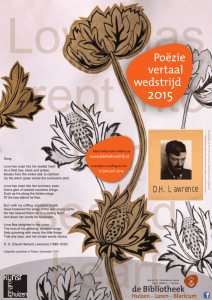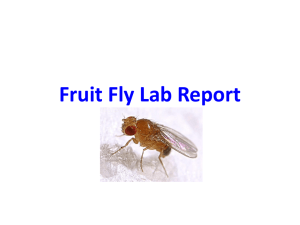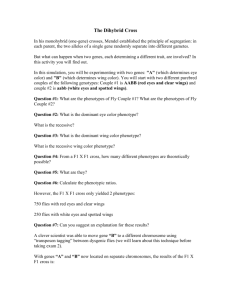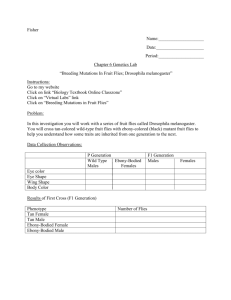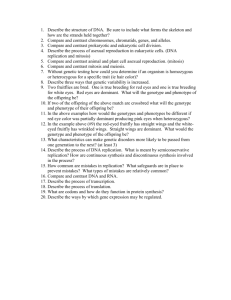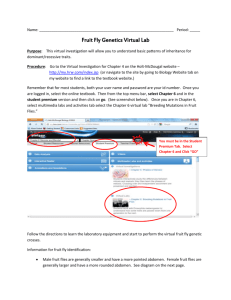Genetics of Drosophila Lab Report Brianna Horn Genetics – Fourth
advertisement
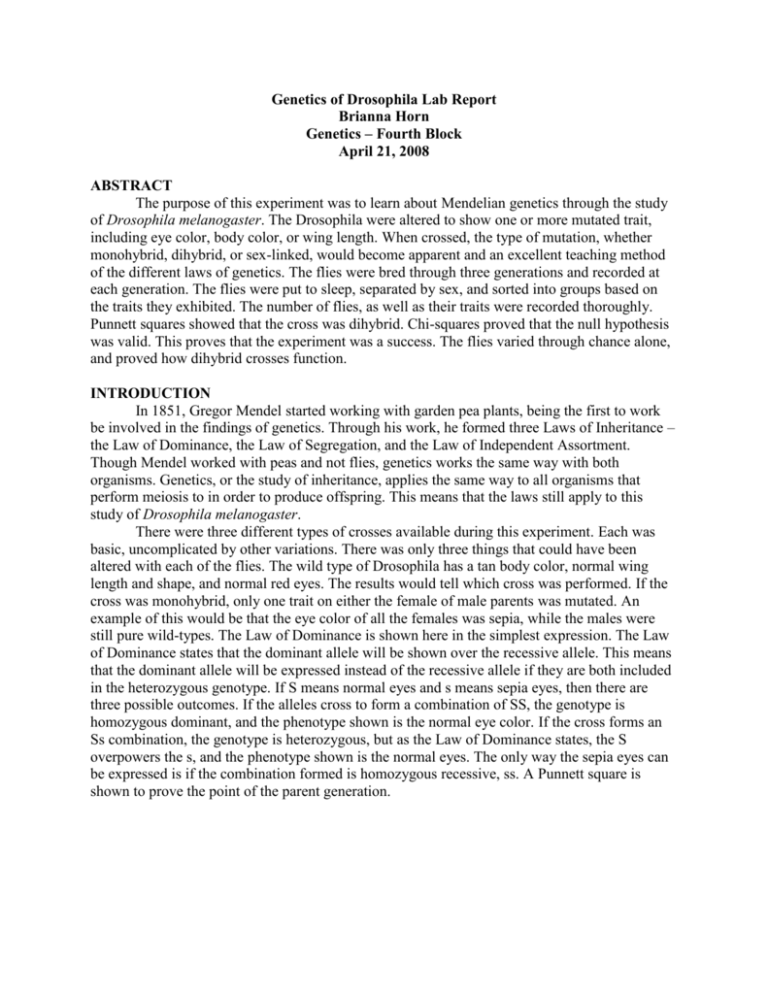
Genetics of Drosophila Lab Report Brianna Horn Genetics – Fourth Block April 21, 2008 ABSTRACT The purpose of this experiment was to learn about Mendelian genetics through the study of Drosophila melanogaster. The Drosophila were altered to show one or more mutated trait, including eye color, body color, or wing length. When crossed, the type of mutation, whether monohybrid, dihybrid, or sex-linked, would become apparent and an excellent teaching method of the different laws of genetics. The flies were bred through three generations and recorded at each generation. The flies were put to sleep, separated by sex, and sorted into groups based on the traits they exhibited. The number of flies, as well as their traits were recorded thoroughly. Punnett squares showed that the cross was dihybrid. Chi-squares proved that the null hypothesis was valid. This proves that the experiment was a success. The flies varied through chance alone, and proved how dihybrid crosses function. INTRODUCTION In 1851, Gregor Mendel started working with garden pea plants, being the first to work be involved in the findings of genetics. Through his work, he formed three Laws of Inheritance – the Law of Dominance, the Law of Segregation, and the Law of Independent Assortment. Though Mendel worked with peas and not flies, genetics works the same way with both organisms. Genetics, or the study of inheritance, applies the same way to all organisms that perform meiosis to in order to produce offspring. This means that the laws still apply to this study of Drosophila melanogaster. There were three different types of crosses available during this experiment. Each was basic, uncomplicated by other variations. There was only three things that could have been altered with each of the flies. The wild type of Drosophila has a tan body color, normal wing length and shape, and normal red eyes. The results would tell which cross was performed. If the cross was monohybrid, only one trait on either the female of male parents was mutated. An example of this would be that the eye color of all the females was sepia, while the males were still pure wild-types. The Law of Dominance is shown here in the simplest expression. The Law of Dominance states that the dominant allele will be shown over the recessive allele. This means that the dominant allele will be expressed instead of the recessive allele if they are both included in the heterozygous genotype. If S means normal eyes and s means sepia eyes, then there are three possible outcomes. If the alleles cross to form a combination of SS, the genotype is homozygous dominant, and the phenotype shown is the normal eye color. If the cross forms an Ss combination, the genotype is heterozygous, but as the Law of Dominance states, the S overpowers the s, and the phenotype shown is the normal eyes. The only way the sepia eyes can be expressed is if the combination formed is homozygous recessive, ss. A Punnett square is shown to prove the point of the parent generation. Monohybrid Parent Generation Cross ♂ ♀ S S s Ss Ss s Ss Ss The results of the Punnett square show that all of the offspring of the parent generation are heterozygous and all show the phenotype of normal eye color. However, when the next generation, the F1 generation, is crossed, the results will be different. Monohybrid F1 Generation Cross ♂ ♀ S s S SS Ss s Ss ss In the F1 cross, both parents are heterozygous. This results in various phenotypes in the offspring. These results show the genotypes of the F2 generation. While the genotype ratios as 1:2:1 (SS:Ss:ss), the phenotype is 3:1 (normal color : sepia color). Seventy-five percent of the offspring will have the normal color eyes, while the twenty-five percent with the ss genotype express the sepia eyes. The Law of Segregation is shown in its basic form as well. The Law of Segregation states that alleles separate in gamete formation. The separated alleles in the Punnett square is a perfect example of this. The alleles separate in order to form a diploid organism with another parent. Another type of cross is a dihybrid cross. In a dihybrid cross, two different traits are mutated. For example, one parent could have an ebony body and normal wings (EEVV), while the other parent could have a normal body with vestigial wings (eevv). The traits do not affect each other. Both traits are separate and the alleles are sorted independently. This is a prime example of the Law of Independent Assortment, where different traits are inherited independently. Dihybrid Parent Generation Cross ♂ ♀ ev ev ev ev EV EV EV EV EeVv EeVv EeVv EeVv EeVv EeVv EeVv EeVv EeVv EeVv EeVv EeVv EeVv EeVv EeVv EeVv All of the F1 generation will have the same phenotype and genotype. They all have the heterozygous genotype EeVv, which produces a phenotype of ebony bodies and normal wings. When the F1 generation crosses, it will be crossing heterozygotes with heterozygotes. This will form a very different outcome. Dihybrid F1 Generation Cross ♂ EV ♀ EV Ev eV ev EEVV EEVv EeVV EeVv EEVv EEvv EeVv Eevv EeVV EeVv eeVV eeVv EeVv Eevv eeVv eevv Ev eV ev Out of these results, nine out of sixteen have a genotype of E_V_, expressing a phenotype of ebony bodies and normal wings. Three out of sixteen have a genotype of E_vv, expressing ebony bodies and vestigial wings. Three out of sixteen have a genotype of eeV_, expressing normal bodies and normal wings. One out of the sixteen is homozygous recessive for both traits, eevv, expressing normal bodies and vestigial wings. These results form a genotypic and phenotypic ratio of 9:3:3:1 (E_V_, ebony body normal wings : E_vv, ebony body vestigial wings : eeV_, normal body normal wings : eevv, normal body vestigial wings). The last possible type of cross that could be encountered during this experiment was sexlinked cross. The sex-linked cross is a little more complicated, as the sex of the Drosophila makes a difference. Sex-linked crosses mean that the allele is on the X chromosome. While females have two X chromosomes, males have one X and one Y. This means that if males have the allele on the X chromosome, they express that trait. Females, however, have two X chromosomes. This means they can carry the trait without necessarily showing it, so long as the trait is recessive. This gives females an advantage over males if the trait is a disease or harmful mutation. Sex-Linked Parent Generation Cross ♂ Xo Y X XXo XY X XXo or XY X Y Xo XXo XoY Xo XXo XoY ♀ ♂ ♀ In both set of results, the females are only carriers of the trait. In order for them to express the trait, both of their parents would need to carry or express the trait. In the first Punnett square, all of the females are carriers and all the males are normal. In the second Punnett square, all of the females are carriers and all of the males express the trait. The mother must have or carry the trait for the son to express the trait. It does not matter what the father has, as he gives his son only the Y chromosome. Sex-Linked F1 Generation Cross ♂ ♀ X Y X XX XY Xo XXo or XoY Xo Y Xo XoXo XoY X XXo XY ♂ ♀ In the first Punnett square, fifty percent of the females are carriers and fifty percent are homozygous dominant. Fifty percent of the males express the trait and fifty percent do not. In the second Punnett square, fifty percent of the females express the trait, and fifty percent are carriers; fifty percent of the males are normal, and fifty percent express the trait. As for this experiment, the female parents had normal eyes and wings, but had ebony bodies, and the males had normal eyes and bodies, but had vestigial wings. Based on these facts, there is a strong possibility that the cross for this set of flies is dihybrid. The F1 generation should come out with ebony bodies and normal wings, as ebony bodies is dominant over normal bodies and normal wings are dominant over vestigial wings. If this is the case, the F2 generation will have a 9:3:3:1 outcome. MATERIALS AND METHODS There are many parts to this experiment. The homozygous parents were paired in a vial full of food on March 16, 2008. They were given about a week to mate and lay eggs, then were removed from the vial on March 25, 2008. In order to remove the flies without allowing them to escape, a cotton swab soaked in Anesthefly was slipped between the foam stopper and the vial. The cotton swab was left in for about two minutes, but not longer, as it would kill the flies. The vial was help upside down while the anesthefly was putting the flies to sleep so the flies did not fall into their food and drown. When all flies were asleep, the foam was removed and all the flies were dumped into a Petri dish. They were then separated based on sex and sorted based on what traits they expressed that differed from the wild type. All data was recorded. The parents were then placed in the fly morgue. The F1 generation, still larva were set in a warm environment to ensure healthy and speedy development. After the larva became flies, five males and five females were anesthetized and transferred into a new vial on March 31, 2008. The new vial had been made earlier. It had a mixture of equal amounts of food and water mixed together at the bottom. It also had a plastic net placed in the middle, and a small amount of coffee paper rolled into a cone shape placed on the net. When more of the F1 generation hatched into flies, they were anesthetized, sexed, sorted, and recorded, then placed in the fly morgue. On April 7, 2008, the parents of the F2 generation were anesthetized and placed in the fly morgue. On April 16, 2008, all of the hatched F2 generation flies were anesthetized, sexed, sorted, and recorded, then placed in the fly morgue. RESULTS Table 1: Phenotypes of the Parental Generation Phenotype No. of Males No. of Females Total Ebony bodies, normal wings, normal eyes 0 7 10 Vestigial wings, normal bodies, normal eyes 3 0 Table 2: Phenotypes of the F1 Generation Phenotype No. of Males No. of Females Ebony bodies, normal wings, normal eyes 127 129 Table 3: Phenotypes of F2 Generation Phenotype No. of Males No. of Females Ebony bodies, normal wings, normal eyes 65 69 Ebony bodies, vestigial wings, normal eyes 29 22 Normal bodies, normal wings, normal eyes 27 33 Normal bodies, vestigial wings, normal eyes 10 13 Total 256 Total 273 Table 4: Punnett Square of Parent Generation Forming Possible F1 Genotypes ♂ ♀ ev ev ev ev EV EV EV EV EeVv EeVv EeVv EeVv EeVv EeVv EeVv EeVv EeVv EeVv EeVv EeVv EeVv EeVv EeVv EeVv Genotype: 100% EeVv Phenotype: 100% ebony bodies, normal wings Table 5: Punnett Square of F1 Generation Forming Possible F2 Genotypes ♂ ♀ EV Ev eV ev EV Ev eV ev EEVV EEVv EeVV EeVv EEVv EEvv EeVv Eevv EeVV EeVv eeVV eeVv EeVv Eevv eeVv eevv Genotype: 9:3:3:1 :: E_V_ : E_vv : eeV_ : eevv Phenotype: 9:3:3:1 :: ebony, normal : ebony, vestigial : normal, vestigial : normal, normal Table 6: Chi Square Test for F2 Generation Phenotype # Observed (o) # Expected (e) E_V_ E_vv eeV_ eevv 134 56 60 23 153 51 51 17 Total 273 273 -19 5 9 6 361 25 81 36 2.36 0.49 1.59 2.12 6.56 DISCUSSION My results showed about a 9:3:3:1 ratio, which is typical of a dihybrid cross. The ebony bodies proved to be dominant, and the vestigial wings proved to be recessive, as the heterozygous F1 flies all had ebony bodies and normal wings. This supports the hypothesis made. The Chi square test had a result of 6.56. As there were four different phenotypes, the number of degrees of freedom was three. As the probability of variations happening on chance alone was ninety-five percent, the critical value was 7.82. As 6.56 is less than 7.82, the null hypothesis is accepted. Any variations in numbers were due to chance alone. The results accurately supported the dihybrid cross explained in the introduction, and follow the pattern of the ratio expected.
